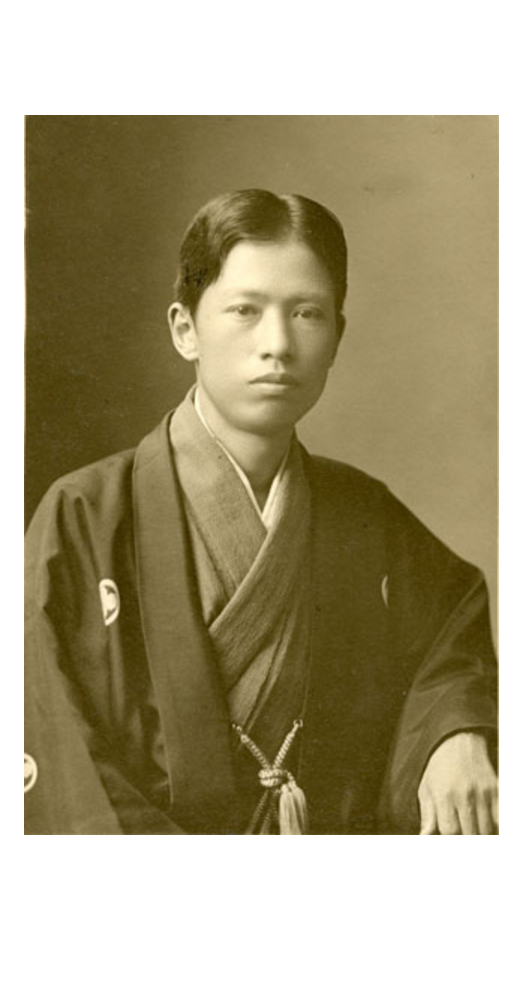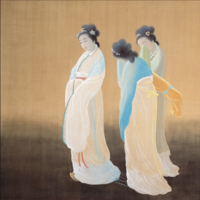More about Hishida Shunsō
Works by Hishida Shunsō

Contributor
The ballad of Hishida Shunsō begins in the mid-19th century, before Hishida was even a twinkle in his mother’s eye.
In vast contrast to the tech-savvy, Harajuku, Japan that we all know and love today, 19th century Japan had a very traditional culture and legal policies in place to maintain said traditions. This culture was called Tokugawa bakufu and was a culture that revolved around romanticizing the samurai class.
When Westerners showed up with their fancy-pantsy battle they thought these wacky warrior-worshipers were as backwards anyone could get (never mind Camelot, Alexander the Great, Greek/Roman war mythology, etc.). To help those zany back-woods Japanese, the kind Westerners threatened to attack the technologically deprived Japanese, who were armed with katanas, with guns and war ships if they refused to give up their isolation and set up a trading post for the West.
In order to fit in with their new BFFs, Japan launched the Meiji Restoration in 1868 to give Japanese culture a jump-start in the modern era. As part of the process, Japan adopted the idea that a country should have one predominant religion, so the government decided to make Shintō their national religion. In the true spirit of the West, Japan started to methodically destroy every Buddhist temple in Japan, ensuring Shintō as the one right and true religion. Civilization, here we come! The Japanese also integrated European and American educational institutions to further expedite the "modernization" process.
Dr. Ernest Fenollsa, however, didn’t agree with the way that Japan was forcing in a Western culture and shoving aside Japanese traditions. A professor of philosophy at the Imperial University of Tokyo, Dr. Ernest Fenollsa advised the Japanese government to preserve indigenous art and traditions rather than destroy them and started a movement to counteract the Tokugawa bakufu movement. It was called nihonga, which promoted the modification of Japanese traditions to allow for their preservation and integration within a modern, uniquely Japanese culture. There was just one problem: Fenollsa was not artistically inclined enough to test his nihonga movement. He relied on young prodigies, like Hishida Shunsō, to put his theories into practice.
Hishida began following Fenollsa as a student and later became a faculty member at the Tokyo Fine Arts School. There he rebelled against The Man and developed a style that was a perfect balance of Japanese art and Western Impressionism. He called it mōrōtai, which literally translates to “vague” and “indistinct”. Hishida, being a very savvy man, realized that the best way to make mōrōtai successful was to make it appeal to Japan’s Asian neighbors, namely China and India where Buddhism was all the rage. Mōrōtai took components and subject matter from traditional Asian art; Buddhist art in particular. Remember how the government tried to get rid of Buddhism, like leaving empty space in a work to let the viewer’s imagination fill in the blanks, or making the subject of the work miniscule in comparison to the surrounding landscape, and blended it with the ill-defined lines and apparent brush strokes of Impressionism.
Mōrōtai was not well received in Japan. To be more precise, the Japanese hated it, partially due to the not-so-authentic Western style and the non-Shintō subjects. The Tokyo Fine Arts School, in true “Dead Poet’s Society” fashion, gave the head of the school the boot to stop him from spreading nihonga around. Sensing his career and art in danger, Hishida packed up and left the Tokyo Fine Arts School.
After leaving the Tokyo Fine Arts School, Hishida decided to take one of his fellow artist and ex-faculty member, Yokoyama Taikan, and travel through Asia and Europe. The two artists and their super-duper controversial style turned out to be insanely popular overseas, their success even crossed the ocean and reached the good ol' U.S. of A. These travels pushed Hishida to play with colors and test the limits of mōrōtai.
Then Hishida suddenly kicked the bucket in 1911 at the age of 32. That was young even for the 1900s. He left behind a series of unfinished works studying the changing colors of leaves, which has never been finished.
Hishida was such a rebellious innovator that he even had to die before everyone else did!

Contributor
The ballad of Hishida Shunsō begins in the mid-19th century, before Hishida was even a twinkle in his mother’s eye.
In vast contrast to the tech-savvy Japan that we all know and love today, 19th century Japan had a very traditional culture and legal policies in place to maintain said traditions. This culture was called Tokugawa bakufu and it revolved around romanticizing the samurai class.
When Westerners showed up with their fancy-pants battleships they thought these wacky warrior worshipers were as backwards anyone could get. To help those zany back-woods Japanese, the kind Westerners threatened to attack the technologically deprived Japanese (who were armed only with katanas) with guns and war ships if they refused to give up their isolation and set up a trading post for the West.
In order to fit in with their new BFFs, Japan launched the Meiji Restoration in 1868 to give Japanese culture a jump-start in the modern era. As part of the process, Japan adopted the idea that a country should have one predominant religion, so the government decided to make Shintō their national religion. In the true spirit of the West, Japan started to methodically destroy every Buddhist temple in Japan, ensuring Shintō as the one right and true religion. Civilization, here we come! The Japanese also integrated European and American educational institutions to further expedite the "modernization" process.
Dr. Ernest Fenollsa, however, didn’t agree with the way that Japan was forcing in a Western culture and shoving aside Japanese traditions. A professor of philosophy at the Imperial University of Tokyo, Dr. Ernest Fenollsa advised the Japanese government to preserve indigenous art and traditions rather than destroy them and started a movement to counteract the Tokugawa bakufu movement. It was called nihonga, which promoted the modification of Japanese traditions to allow for their preservation and integration with a modern, uniquely Japanese culture. There was just one problem: Fenollsa was not artistically inclined enough to test this nihonga idea. He relied on young prodigies, like Hishida Shunsō, to put his theories into practice.
Hishida began following Fenollsa as a student and later became a faculty member at the Tokyo Fine Arts School. There, he rebelled against The Man and developed a style that was a perfect balance of Japanese art and Western Impressionism. He called it mōrōtai, which literally translates to “vague” and “indistinct”. Hishida, being a very savvy man, realized that the best way to make mōrōtai successful was to make it appeal to Japan’s Asian neighbors, namely China and India where Buddhism was all the rage. Mōrōtai took components and subject matter from traditional Asian art (Buddhist art in particular. Remember how the government tried to get rid of Buddhism?), like leaving empty space in a work to let the viewer’s imagination fill in the blanks, or making the subject of the work miniscule in comparison to the surrounding landscape, and blended it with the ill-defined lines and apparent brush strokes of Impressionism.
Mōrōtai was not well received in Japan. To be more precise, the Japanese hated it, partially due to the not-so-authentic Western style and the non-Shintō subjects. The Tokyo Fine Arts School, in true “Dead Poet’s Society” fashion, gave the head of the school the boot to stop him from spreading nihonga around. Sensing his career and art in danger, Hishida packed up and left the Tokyo Fine Arts School.
After leaving the Tokyo Fine Arts School, Hishida decided to take one of his fellow artists and ex-faculty member, Yokoyama Taikan, and travel through Asia and Europe. The two artists and their super-duper controversial style turned out to be insanely popular overseas, their success even crossed the ocean and reached the U.S. of A. These travels pushed Hishida to play with colors and test the limits of mōrōtai.
Then Hishida suddenly kicked the bucket in 1911 at the age of 32. That was young even for the 1900s. He left behind a series of unfinished works studying the changing colors of leaves, which has never been finished.
Hishida was such a rebel that he even had to die before everyone else did!
Sources
- http://www.japantimes.co.jp/culture/2014/10/16/arts/less-meant-more-to-…
- http://www.ukiyoe-ota-muse.jp/exhibition-eng/mizuno-toshikata
- Japanese Art by Joan Stanley-Baker
Featured Content
Here is what Wikipedia says about Hishida Shunsō

Hishida Shunsō (菱田 春草, September 21, 1874 – September 16, 1911) was the pseudonym of a Japanese painter from the Meiji period. One of Okakura Tenshin's pupils along with Yokoyama Taikan and Shimomura Kanzan, he played a role in the Meiji era innovation of Nihonga. His real name was Hishida Miyoji. He was also known for his numerous paintings of cats.
Check out the full Wikipedia article about Hishida Shunsō











